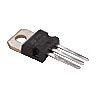Components are the electronic parts that make your robot think, act, and search for what you program it to do.
Fixed Resistors
Fixed resistors supply a resistance measured in ohms to a circuit. The higher the ohms, the more resistance. The resistor below shows how one would look like. The first bar sets the initial number (in this case, 1), the second is an assistant (add on a 5). The third bar is a multiplier (that means 15 times 100 = 1500 or 15k ohms). The final bar is the tolerance bar (meaning this resistor can vary + or - 10%).

If you don't want to take the time to figure out what the value of the resistor is, you can also use a multi-tester to measure the resistance of the resistor.
Variable Resistors
Variable resistors differ from fixed in that they either slide or rotate to adjust the resistance to where you need it for your certain project.

Fixed and Variable Capacitors
Fixed capacitors hold an electrical charge for a predetermined amount of time. The value of the capacitor is printed on the component. Smaller capacitors us a bit different system. Say it's marked with 104. That means it's a 10 with 4 zeros (104 = 100,000). Sometimes you'll see a "WV" after the voltage rating which means you can't use the capacitor with voltages exceeding this rating. You'll also find a polarity marking (- minus sign) that identifies the negative side of the capacitor and must be installed accordingly to prevent failure.




Diodes
Diodes are made of either germanium or silicon. They carry two ratings: peak inverse voltage and current. These ratings are the maximum amount of each that a diode can handle. For instance, a 5 amp diode can only handle 5 amps before failure. They, like capacitors, have a marking (a cathode band) denoting the negative terminal. Light-emitting diodes (LED) emit infrared light, have a PIV rating of 100 to 150 volts, a maximum current rating of 40 milliamps, are powered in low-powered DC circuits of 12 volts or less, and are used with a resistor to limit the current.

Transistors
Transistors are divided into two catagories: signal, where they amplify a signal in things such as radios, telephones, etc., and power, where they switch a signal on or off in things such as motor drivers and power supplies. Size is usually a way to tell the two apart. Transistor are identified by a unique code, like 2N2222 or MPS6519, designating what kind of application they are for. To find this out, refer to a data book to locate the different characteristics and ratings. A signal transistor is small and can come in either a plastic or metal case. A power transistor is larger and always has a metal case to dissipate heat.


Integrated Circuits
Integrated circuits are the backbone of any electronics device. They often come a dual in-line packages (DIP). Most common ICs are 8-, 14-, and 16- pin. ICs also have a unique code, such as 7400 or 4017, which you can look up in a data book to find specifications and parameters. Some contain catalog numbers and should not be confused with the code.

Question: Great! Now I have an education in Electronic Parts 101. How am I supposed to know what to do with them?
Answer: Glad you see this as a class instead of a bore. Now you need to learn about electronic design and construction.